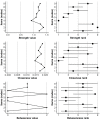Validation of the Social Media Disorder Scale using network analysis in a large representative sample of Czech adolescents
- PMID: 36072384
- PMCID: PMC9441909
- DOI: 10.3389/fpubh.2022.907522
Validation of the Social Media Disorder Scale using network analysis in a large representative sample of Czech adolescents
Abstract
Background: The importance of studying the excessive use of social media in adolescents is increasing and so is the need for in-depth evaluations of the psychometric properties of the measurement tools. This study investigated the properties of the Social Media Disorder Scale (SMDS) in a large representative sample of Czech adolescents.
Methods: We analyzed the representative sample of 13,377 Czech adolescents (50.9% boys), 11-16 years old, who participated in the Health Behavior in School-aged Children (HBSC) survey (2017-18), using confirmatory factor analysis (CFA) and network models. Furthermore, we evaluated the measurement invariance and constructed the validity of the SMDS.
Results: We found support for a single dominant factor but not for strict unidimensionality. Several residual correlations were identified. The strongest were for: problems-conflicts-deceptions; persistence-escape; and preoccupation-tolerance-withdrawal. Girls, particularly 13- and 15-year-olds, scored higher than boys in the same age group, and 13- and 15-year-olds achieved higher scores than 11-year-olds, although some items were not invariant between the groups. The SMDS was positively related to other online activities, screen time, and falling asleep late, but negatively related to well-being and mental health.
Discussion and conclusions: The SMDS showed solid psychometric properties and construct validity. However, small violations of measurement invariance were detected. Furthermore, the network analysis showed important residual relationships between the items.
Keywords: Health Behavior in School-aged Children (HBSC); Network analysis; adolescents; problematic social media use (PSMU); psychometrics; social media addiction; validation.
Copyright © 2022 Šablatúrová, Rečka and Blinka.
Conflict of interest statement
The authors declare that the research was conducted in the absence of any commercial or financial relationships that could be construed as a potential conflict of interest.
Figures





Similar articles
-
Cross-national validation of the social media disorder scale: findings from adolescents from 44 countries.Addiction. 2022 Mar;117(3):784-795. doi: 10.1111/add.15709. Epub 2021 Oct 24. Addiction. 2022. PMID: 34605094 Free PMC article.
-
Validation of the Social Media Disorder Scale in Adolescents: Findings From a Large-Scale Nationally Representative Sample.Assessment. 2022 Dec;29(8):1658-1675. doi: 10.1177/10731911211027232. Epub 2021 Jun 30. Assessment. 2022. PMID: 34189943 Free PMC article.
-
Spanish validation of two social media appearance-related constructs associated with disordered eating in adolescents: The Appearance-related Social Media Consciousness scale (ASMC) and the Critical Thinking about Media Messages scale (CTMM).Body Image. 2023 Jun;45:401-413. doi: 10.1016/j.bodyim.2023.04.004. Epub 2023 May 1. Body Image. 2023. PMID: 37137258
-
The seven deadly sins: measuring overvaluation of social media with the Plan-net 25 scale.BMC Psychol. 2025 May 27;13(1):569. doi: 10.1186/s40359-025-02801-1. BMC Psychol. 2025. PMID: 40426206 Free PMC article.
-
Psychometric Properties of Screening Instruments for Social Network Use Disorder in Children and Adolescents: A Systematic Review.JAMA Pediatr. 2023 Apr 1;177(4):419-426. doi: 10.1001/jamapediatrics.2022.5741. JAMA Pediatr. 2023. PMID: 36806892
Cited by
-
Screen time and addictive use of gaming and social media in relation to health outcomes.Front Psychol. 2023 Dec 18;14:1258784. doi: 10.3389/fpsyg.2023.1258784. eCollection 2023. Front Psychol. 2023. PMID: 38192395 Free PMC article.
References
-
- Allen KA, Ryan T, Gray DL, McInerney DM, Waters L. Social media use and social connectedness in adolescents: the positives and the potential pitfalls Educ Dev Psychol. (2014) 31:18–31. 10.1017/edp.2014.2 - DOI
-
- Keles B, McCrae N, Grealish A. A systematic review: the influence of social media on depression, anxiety and psychological distress in adolescents. Int J Adolesc Youth. (2020) 25:79–93. 10.1080/02673843.2019.1590851 - DOI
-
- Müller KW, Dreier M, Beutel ME, Duven E, Giralt S, Wölfling K. A hidden type of internet addiction? Intense and addictive use of social networking sites in adolescents. Comput Hum Behav. (2016) 55:172–7. 10.1016/j.chb.2015.09.007 - DOI
-
- American Psychiatric Association . Diagnostic and Statistical Manual of Mental Disorders (DSM-5). 5th ed. Washington, DC: American Psychiatric Association; (2013).
Publication types
MeSH terms
LinkOut - more resources
Full Text Sources

